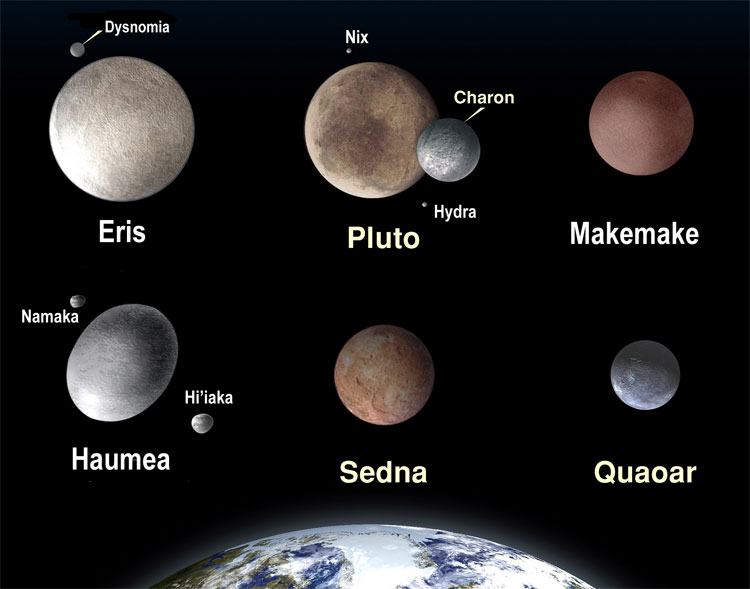ASTB03 Assignment 4
ASTB03 Assignment 4 Mark - 6110
Pluto is one of the largest bodies that belongs to the Kuiper belt, a disc of rocky, icy, and relatively small bodies that orbit past Neptune. Pluto was discovered in 1930, and from then until 2006 was considered the 9th planet in the Solar System. After much debate, Pluto was reclassified from planet to dwarf planet in 2006. The reclassification of Pluto was largely due to the discovery of many bodies (such as Eris, a body significantly more massive than Pluto) in the Kuiper belt area of similar size. Either Pluto had to be reclassified, or we would have significantly more planets in our Solar System (as other bodies would also have to be relabeled as planets). The new planet classification system introduced the following constraints to define a planet:
- The body must orbit around the Sun
- The body must be roughly spherical. This occurs when the mass of the body is large enough to pull itself inwards.
- The neighbourhood around the body's orbit should be clear, as the body must be massive enough to absorb space debris in its orbit.
Pluto was reclassified as a dwarf planet as it does not meet the third constraint.
Pluto was discovered in 1930 by American astronomer Clyde Tombaugh. Clyde was born in Illinois in 1906 to a farm family. He was fascinated with astronomy and built many lenses and telescopes himself in his early twenties. In 1928, he started a career at Lowell Observatory, where he worked until 1945. It is during this career that Tombaugh is credited with the discovery of hundreds of asteroids, and most importantly, Pluto. In his search for a planet beyond Neptune, Clyde took photographs of the same region in the sky at different times. He would then compare the photographs, and if any object in them moved, then it must be a moving object such as a planet or asteroid. Clyde was aided in the fact that prior to him, two astronomers: Percival Lowell and William Henry Pickering had theorized the existence of a ninth planet "Planet X". This theoretical planet would be beyond the orbit of Neptune. They believed such a planet must exist, as the orbits of Uranus and Neptune deviated slightly from the predicted orbits. This deviation had to be the result of other massive objects in the Solar System pulling on Neptune and Uranus, hence Planet X. Using the predicted locations of Planet X by William and Percival, Clyde knew where to look for and ultimately found Pluto. Due to this, similarly to Neptune, Pluto was indeed discovered due to a truly theoretical prediction based on celestial mechanics.
Even after its discovery, due to its tremendous distance not much was known about Pluto. Due to the effects seen on Neptune and Uranus, its mass was originally theorized to be similar to the mass of Earth. However, further calculations continued to bring the theorized mass downwards. In 1978, a more precise prediction of Pluto's mass was made, as one of Pluto's moons "Charon" was discovered. The mass was found to be 0.2% of the mass of the Earth. This small mass is not enough to have the theorized impact on the orbits of Neptune and Uranus. Thus, the discovery of Pluto has been deemed a coincidence.
 Plutinos are a group of small icy bodies in the Kuiper belt that have distinct orbital relationships with Neptune. Pluto is the biggest member of the plutinos. The first plutino (other than Pluto) that was discovered was (385185) 1993 RO, discovered in 1993. Plutinos are a subset of a larger group called plutoids. The difference is that plutinos must have a relationship with Neptune's orbit, while plutoids do not. A plutoid is any body that orbits the sun past Neptune, and is massive enough to be roughly spherical in shape. There are four official plutoids (stated by the IAU), but it is theorized that there could be thousands. One such plutoid is Eris. Eris is also a dwarf planet in the Kuiper belt. It is more massive but smaller in size than Pluto. Eris was discovered in 2005, and is partially responsible for the demotion of Pluto as a planet, as if Pluto was a planet, then certainly a more massive Eris would also have to be considered a planet.
Plutinos are a group of small icy bodies in the Kuiper belt that have distinct orbital relationships with Neptune. Pluto is the biggest member of the plutinos. The first plutino (other than Pluto) that was discovered was (385185) 1993 RO, discovered in 1993. Plutinos are a subset of a larger group called plutoids. The difference is that plutinos must have a relationship with Neptune's orbit, while plutoids do not. A plutoid is any body that orbits the sun past Neptune, and is massive enough to be roughly spherical in shape. There are four official plutoids (stated by the IAU), but it is theorized that there could be thousands. One such plutoid is Eris. Eris is also a dwarf planet in the Kuiper belt. It is more massive but smaller in size than Pluto. Eris was discovered in 2005, and is partially responsible for the demotion of Pluto as a planet, as if Pluto was a planet, then certainly a more massive Eris would also have to be considered a planet.Bibliography:
https://www.space.com/19824-clyde-tombaugh.html
http://www-history.mcs.st-andrews.ac.uk/HistTopics/Neptune_and_Pluto.html
https://www.space.com/43-pluto-the-ninth-planet-that-was-a-dwarf.html
https://www.nasa.gov/audience/forstudents/k-4/stories/nasa-knows/what-is-pluto-k4.html
https://cseligman.com/text/planets/plutoid.htm
https://www.universetoday.com/77359/plutoid/
https://en.wikipedia.org/wiki/Clyde_Tombaugh
https://en.wikipedia.org/wiki/William_Henry_Pickering
https://en.wikipedia.org/wiki/Pluto
https://en.wikipedia.org/wiki/Plutino
https://en.wikipedia.org/wiki/Plutoid
https://en.wikipedia.org/wiki/Pluto
https://en.wikipedia.org/wiki/Plutino
https://en.wikipedia.org/wiki/Plutoid
Comments
Post a Comment